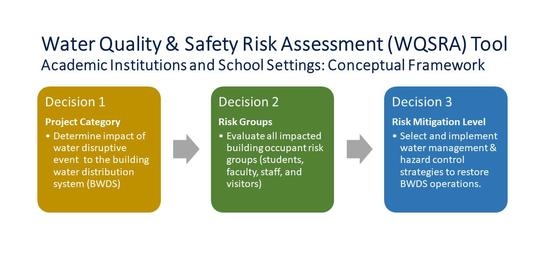Managing Building Water Disruptions in a Post-COVID World: Water Quality and Safety Risk Assessment Tool for Academic Institutions and School Settings
Abstract
:1. Introduction
1.1. Disruptive Water Events
1.2. Green Building Design and Water System Challenges
1.3. Municipal Water Supply Changes
1.4. Water Management Policies for BWDS
1.5. Risk Decision Matrix and Water Management
2. Materials and Methods
2.1. Developing WQSRA Project Types
2.1.1. Adjusting for Water Age/Dormancy
2.1.2. Defining Disruptive Event and Scope of Work for Water System Components
2.2. Defining Building Area Risk Groups
2.3. Developing WQSRA Risk Mitigation Strategies
3. Results
3.1. WQSRA Project Categories
3.1.1. Water Disruption Scope of Work
3.1.2. Stratified Water Age Categories
3.2. WQSRA Building Occupant Risk Groups
3.3. Risk Mitigation Levels
3.4. WQSRA Verification and Validation Testing
4. Discussion
4.1. Variable Building Occupancy (Seasonal, Low-Density, or Emergency Conditions)
4.2. Increasing Water Management Policy Statutes
4.3. Green Building Design (GBD) Impact
4.3.1. GBD and Educational Mission
4.3.2. GBD and Water Quality
4.3.3. GBD and Healthy Building Rating and Certification Programs
4.4. Education Campuses and Community Water Supply Systems
4.5. Liability, Financial Risk, and Reputational Harm
4.6. Limitations
5. Conclusions
- Reduce the likelihood of a disease case, injury, or death from a water-disruptive event due to water quality or safety issue emerging from the BWDS;
- Reduce the likelihood of a water quality or safety issue from a water-disruptive event in a BWDS undergoing any project maintenance, repairs, or involving construction activities;
- Reduce the likelihood of unintended health consequences in BWDSs from design professionals utilizing building or certification systems focusing primarily on green building design initiatives without consideration of water quality and safety;
- Improve regulatory alignment for building owners with emerging new state policies requiring risk mitigation for water chemistry or waterborne pathogen growth and spread in BWDSs;
- Extend public health training to include comprehensive WMP methods for catastrophic events, water disruption, and construction activities.
Supplementary Materials
Author Contributions
Funding
Data Availability Statement
Conflicts of Interest
References
- Hozalski, R.M.; LaPara, T.M.; Zhao, X.; Kim, T.; Waak, M.B.; Burch, T.; McCarty, M. Flushing of Stagnant Premise Water Systems after the COVID-19 Shutdown Can Reduce Infection Risk by Legionella and Mycobacterium spp. Environ. Sci. Technol. 2020, 54, 15914–15924. [Google Scholar] [CrossRef] [PubMed]
- Ghoochani, S.; Salehi, M.; DeSimone, D.; Salehi Esfandarani, M.; Bhattacharjee, L. Studying the impacts of non-routine extended schools’ closure on heavy metal release into tap water. Environ. Sci. Water Res. Technol. 2022, 8, 1223–1235. [Google Scholar] [CrossRef]
- Ye, C.; Xian, X.; Bao, R.; Zhang, Y.; Feng, M.; Lin, W.; Yu, X. Recovery of microbiological quality of long-term stagnant tap water in university buildings during the COVID-19 pandemic. Sci. Total Environ. 2022, 806, 150616. [Google Scholar] [CrossRef] [PubMed]
- Salehi, M.; DeSimone, D.; Aghilinasrollahabadi, K.; Ahamed, T. A case study on tap water quality in large buildings recommissioned after extended closure due to the COVID-19 pandemic. Environ. Sci. Water Res. Technol. 2021, 7, 1996–2009. [Google Scholar] [CrossRef]
- Liang, J.; Swanson, C.S.; Wang, L.; He, Q. Impact of building closures during the COVID-19 pandemic on Legionella infection risks. Am. J. Infect. Control 2021, 49, 1564–1566. [Google Scholar] [CrossRef]
- WHO. Water, Sanitation, Hygiene, and Waste Management for SARS-CoV-2, the Virus That Causes COVID-19. Available online: https://www.who.int/publications/i/item/WHO-2019-nCoV-IPC-WASH-2020.4 (accessed on 12 January 2023).
- CDC. Reopening Buildings after Prolonged Shutdown or Reduced Operation. Available online: https://www.cdc.gov/nceh/ehs/water/legionella/building-water-system.html (accessed on 15 August 2022).
- EPA. Information on Maintaining or Restoring Water Quality in Buildings with Low or No Use. Available online: https://www.epa.gov/coronavirus/information-maintaining-or-restoring-water-quality-buildings-low-or-no-use (accessed on 15 August 2022).
- Leslie, E.; Hinds, J.; Hai, F.I. Causes, factors and control measures of opportunistic premise plumbing pathogens—A critical review. Appl. Sci. 2021, 11, 4474. [Google Scholar] [CrossRef]
- Gamage, S.D.; Ambrose, M.; Kralovic, S.M.; Roselle, G.A. Water Safety and Health Care: Preventing Infections Caused by Opportunistic Premise Plumbing Pathogens. Infect. Dis. Clin. N. Am. 2021, 35, 667–695. [Google Scholar] [CrossRef]
- UN-Water. Water Facts: Water and Disasters. Available online: https://www.unwater.org/water-facts/water-and-disasters (accessed on 15 March 2023).
- National Academies of Sciences, Engineering and Medicine. Management of Legionella in Water Systems; The National Academies Press: Washington, DC, USA, 2020; p. 290. [Google Scholar]
- Rios, E. Jackson water crisis heaps more disruption on city’s schoolchildren. The Guardian, 31 August 2022. [Google Scholar]
- Roberts, N. How Jackson State University Survived the Water Crisis. BET Lifestyle, 30 September 2022. [Google Scholar]
- Maher, K.; Fung, E. Residents Not Yet Permitted to Return Home after Ohio Derailment—Officials Continue to Monitor Air and Water in East Palestine after Chemicals Released. The Wall Street Journal, 7 February 2023. [Google Scholar]
- Martin, B.; Clark-Ginsberg, A. Ohio’s train derailment shows the real national security threat. The Los Angeles Times, 19 February 2023. [Google Scholar]
- Kot, M.; Payne, S.J. Take a Proactive Risk Management Approach to Protect Public Health. Opflow 2022, 48, 20–22. [Google Scholar] [CrossRef]
- Garrison, L.E.; Kunz, J.M.; Cooley, L.A.; Moore, M.R.; Lucas, C.; Schrag, S.; Sarisky, J.; Whitney, C.G. Vital Signs: Deficiencies in Environmental Control Identified in Outbreaks of Legionnaires’ Disease—North America, 2000–2014. Am. J. Transplant. 2016, 16, 3049–3058. [Google Scholar] [CrossRef]
- Scanlon, M.M.; Gordon, J.L.; McCoy, W.F.; Cain, M.F. Water management for construction: Evidence for risk characterization in community and healthcare settings: A systematic review. Int. J. Environ. Res. Public Health 2020, 17, 2168. [Google Scholar] [CrossRef] [Green Version]
- Proctor, C.R.; Rhoads, W.J.; Keane, T.; Salehi, M.; Hamilton, K.; Pieper, K.J.; Cwiertny, D.M.; Prévost, M.; Whelton, A.J. Considerations for large building water quality after extended stagnation. AWWA Water Sci. 2020, 2, e1186. [Google Scholar] [CrossRef] [PubMed]
- Rhoads, W.J.; Keane, T.; Spencer, M.S.; Pruden, A.; Edwards, M.A. Did Municipal Water Distribution System Deficiencies Contribute to a Legionnaires’ Disease Outbreak in Quincy, IL? Environ. Sci. Technol. Lett. 2020, 7, 896–902. [Google Scholar] [CrossRef]
- Faccini, M.; Russo, A.G.; Bonini, M.; Tunesi, S.; Murtas, R.; Sandrini, M.; Senatore, S.; Lamberti, A.; Ciconali, G.; Cammarata, S.; et al. Large community-acquired Legionnaires’ disease outbreak caused by Legionella pneumophila serogroup 1, Italy, July to August 2018. Euro Surveill. Bull. Eur. Sur Les Mal. Transm. 2020, 25, 1900523. [Google Scholar] [CrossRef] [PubMed]
- Pieprz, D.; Sheth, R.; Zhang, T. Rethinking the Future of the University Campus. J. Green Build. 2021, 16, 253–274. [Google Scholar] [CrossRef]
- Chen, Q.; Kleinman, L.; Dial, A. Energy performance of campus Leed® buildings: Implications for green building and energy policy. J. Green Build. 2015, 10, 137–160. [Google Scholar] [CrossRef]
- Rhoads, W.J.; Pearce, A.; Pruden, A.; Edwards, M.A. Anticipating the Effects of Green Buildings on Water Quality and Infrastructure. J.-Am. Water Work. Assoc. 2015, 107, 50–61. [Google Scholar] [CrossRef]
- Rhoads, W.J.; Pruden, A.; Edwards, M.A. Survey of green building water systems reveals elevated water age and water quality concerns. Environ. Sci. Water Res. Technol. 2016, 2, 164–173. [Google Scholar] [CrossRef] [Green Version]
- CMS. Requirement to Reduce Legionella Risk in Healthcare Facility Water Systems to Prevent Cases and Outbreaks of Legionnaires’ Disease; CMS: Baltimore, MD, USA, 2018; pp. 1–3. [Google Scholar]
- ANSI/ASHRAE Standard 188-2021. Legionellosis: Risk Management for Building Water Systems; ASHRAE: Peachtree Corners, GA, USA, 2021; pp. 1–24.
- CDC. Developing a Water Management Program to Reduce Legionella Growth and Spread in Buildings: A Practical Guide to Implementing Industry Standards; CDC: Atlanta, GA, USA, 2021; pp. 1–36. [Google Scholar]
- Collier, S.A.; Deng, L.; Adam, E.A.; Benedict, K.M.; Beshearse, E.M.; Blackstock, A.J.; Bruce, B.B.; Derado, G.; Edens, C.; Fullerton, K.E.; et al. Estimate of burden and direct healthcare cost of infectious waterborne disease in the United States. Emerg. Infect. Dis. 2021, 27, 140–149. [Google Scholar] [CrossRef]
- CDC. Waterborne Disease & Outbreak Surveillance Reporting: Findings. Available online: https://www.cdc.gov/healthywater/surveillance/burden/findings.html (accessed on 15 February 2023).
- Reynolds, K.A.; Mena, K.D.; Gerba, C.P. Risk of Waterborne Illness via Drinking Water in the United States. Rev. Environ. Contam. Toxicol. 2008, 192, 117–158. [Google Scholar] [CrossRef]
- CDC. Addressing the Challenges of Water-Related Illnesses in the United States—Contaminated Water Can Cause Many Different Illnesses; CDC: Atlanta, GA, USA, 2019; p. 4. [Google Scholar]
- CDC. Legionella About the Disease: History, Burden and Trends. Available online: https://www.cdc.gov/legionella/about/history.html (accessed on 15 February 2023).
- Wiener, S. California SB1144: Water Efficiency and Quality Assessment Reports for State Buildings and Public School Buildings; Assembly Committee on Education: Sacramento, CA, USA, 2022; p. 10. [Google Scholar]
- Cappel, M.; Murphy, L.; Johnson, A.; Manley, N.; Ugaste, D.; Hurley, F.; Vella, D.; Williams, J. Illinois Amended Section 5-19.11 Environmental Protection Act: Public Water Supply Disruption Notification; Illinois General Assembly: Springfield, IL, USA, 2022; p. 4. [Google Scholar]
- Pittman, J.; Fontana, W.; Kane, J.; Hughes, V.; Cappilletti, A.; Costa, J.; Schwank, J.; Aument, R.; Martin, S.; Yaw, G.; et al. Pennsylvania SB 1125: Legionnaires’ Disease Risk Management in Public Water Systems; The General Assembly of Pennsylvania: Harrisburg, PA, USA, 2022; p. 17. [Google Scholar]
- New York State Department of Health. Legionnaires’ Disease and Legionella. Available online: https://www.health.ny.gov/diseases/communicable/legionellosis/ (accessed on 3 August 2022).
- New York State Department of Health-Regional Epidemiology. Environmental Health Information Related to Legionellosis in Healthcare Facilities; New York State Department of Health: Albany, NY, USA, 2019; p. 17. [Google Scholar]
- Grigg, N.S. President Biden’s Infrastructure Plan: Does it address needs of water systems in the United States? Int. J. Water Resour. Dev. 2022, 38, 346–350. [Google Scholar] [CrossRef]
- Beaven, L. Biden Infrastructure Plan includes Billions for Water Utilities, Waste Sites. Inside EPA Weekly Report, 9 April 2021; Volume 42. [Google Scholar]
- National Center for Education Statistics. Table 105.50. Number of Educational Institutions, by Level and Control of Institution 2009–10 through 2019–20. Available online: https://nces.ed.gov/programs/digest/d21/tables/dt21_105.50.asp (accessed on 16 February 2023).
- Duijm, N.J. Recommendations on the use and design of risk matrices. Saf. Sci. 2015, 76, 21–31. [Google Scholar] [CrossRef] [Green Version]
- Radu, T.; Balint, L.; Istrate, G.G.; Tudor, B. Environmental Risk Assessment by Risk Matrix Method. In Proceedings of the International Multidisciplinary Scientific GeoConference, Sofia, Bulgaria, 29 June–5 July 2017; pp. 395–401. [Google Scholar]
- Pickering, A.; Cowley, S. Risk Matrices: Implied accuracy and false assumptions. J. Health Saf. Res. Pract. 2010, 2, 11–18. [Google Scholar]
- AIHA Control Banding Working Group. Guidance for Conducting Control Banding Analyses; American Industrial Hygiene Association: Fairfax, VA, USA, 2007. [Google Scholar]
- Lentz, T.; Seaton, M.; Rane, P.; Gilbert, S.; McKernan, L.; Whittaker, C. The NIOSH Occupational Exposure Banding Process for Chemical Risk Management; Technical Report 0097-6326; Federal Information & News Dispatch, LLC: Cincinnati, OH, USA, July 2019; p. 156. [Google Scholar]
- APIC. Infection Prevention Manual for Construction & Renovation, 1st ed.; Vogel, R., Ed.; Association for Professionals in Infection Control and Epidemiology: Arlington, VA, USA, 2015; p. 164. [Google Scholar]
- Bartley, J.M. APIC State-of-the-Art Report: The role of infection control during construction in health care facilities. Am. J. Infect. Control 2000, 28, 156–169. [Google Scholar] [CrossRef]
- Scanlon, M.M.; Gordon, J.L.; Tonozzi, A.A.; Griffin, S.C. Reducing the Risk of Healthcare Associated Infections from Legionella and Other Waterborne Pathogens Using a Water Management for Construction (WMC) Infection Control Risk Assessment (ICRA) Tool. Infect. Dis. Rep. 2022, 14, 341–359. [Google Scholar] [CrossRef] [PubMed]
- Quiroga, C.; Ford, D.; Taylor, T.; Kranc, S.; Kraus, E. Construction specification framework for utility installations. Transp. Res. Rec. 2008, 2060, 162–172. [Google Scholar] [CrossRef]
- Calmuc, V.A.; Calmuc, M.; Arseni, M.; Topa, C.M.; Timofti, M.; Burada, A.; Iticescu, C.; Georgescu, L.P. Assessment of heavy metal pollution levels in sediments and of ecological risk by quality indices, applying a case study: The lower danube river, romania. Water 2021, 13, 1801. [Google Scholar] [CrossRef]
- Piazza, S.; Sambito, M.; Freni, G. A Novel EPANET Integration for the Diffusive-Dispersive Transport of Contaminants. Water 2022, 14, 2707. [Google Scholar] [CrossRef]
- Ley, C.J.; Proctor, C.R.; Jordan, K.; Ra, K.; Noh, Y.; Odimayomi, T.; Julien, R.; Kropp, I.; Mitchell, J.; Nejadhashemi, A.P.; et al. Impacts of Municipal Water-Rainwater Source Transitions on Microbial and Chemical Water Quality Dynamics at the Tap. Environ. Sci. Technol. 2020, 54, 11453–11463. [Google Scholar] [CrossRef]
- Allen, J.G.; Macomber, J.D. Healthy Buildings: How Indoor Spaces Can Make You Sick—Or Keep You Well; Harvard University Press: Cambridge, MA, USA, 2022; p. 313. [Google Scholar]
- ASHRAE Guideline 12-2020. Managing the Risk of Legionellosis Associated with Building Water Systems; ASHRAE: Peachtree Corners, GA, USA, 2020; pp. 1–54.
- CDC. Toolkit for Controlling Legionella in Common Sources of Exposure: Information on Controlling Legionella in Commonly Implicated Sources of Legionnaires’ Disease Outbreaks; CDC: Atlanta, GA, USA, 2021; pp. 1–27. [Google Scholar]
- US Department of Veterans Affairs. Prevention of Health Care-Associated Legionella Disease and Scald Injury from Water Systems; VHA Directive 1061; US Department of Veterans Affairs: Washington, DC, USA, 2021; p. 60. [Google Scholar]
- Singh, R.; Hamilton, K.A.; Rasheduzzaman, M.; Yang, Z.; Kar, S.; Fasnacht, A.; Masters, S.V.; Gurian, P.L. Managing water quality in premise plumbing: Subject matter experts’ perspectives and a systematic review of guidance documents. Water 2020, 12, 347. [Google Scholar] [CrossRef] [Green Version]
- Kanamori, H.; Weber, D.J.; Rutala, W.A. Healthcare outbreaks associated with a water reservoir and infection prevention strategies. Clin. Infect. Dis. 2016, 62, 1423–1435. [Google Scholar] [CrossRef]
- Yiek, W.-K.; Coenen, O.; Nillesen, M.; Ingen, J.v.; Bowles, E.C.; Tostmann, A. Outbreaks of healthcare-associated infections linked to water-containing hospital equipment: A literature review. Antimicrob. Resist. Infect. Control 2021, 10, 77–96. [Google Scholar] [CrossRef] [PubMed]
- Rhoads, W.J.; Pruden, A.; Edwards, M.A. Interactive Effects of Corrosion, Copper, and Chloramines on Legionella and Mycobacteria in Hot Water Plumbing. Environ. Sci. Technol. 2017, 51, 7065–7075. [Google Scholar] [CrossRef] [PubMed]
- Van Kenhove, E.; Dinne, K.; Janssens, A.; Laverge, J. Overview and comparison of Legionella regulations worldwide. Am. J. Infect. Control 2019, 47, 968–978. [Google Scholar] [CrossRef] [PubMed] [Green Version]
- Avis, E. Focusing on water issues through ASHRAE standard. ASHE Health Facilities Management, 22 February 2022; p. 1. [Google Scholar]
- Morgan, J. New York City adopts ASHRAE Legionella Standard. ASHE Health Facilities Management, 21 August 2015; p. 1. [Google Scholar]
- Sequeira, K. Governor vetoes bill to revmoew lead from water at schools. EDSource News Update, 30 September 2022. [Google Scholar]
- Bessler, K. Legislation aims to protect health care facilities from pathogens in water supplies. The Center Square, 23 April 2022; p. 1. [Google Scholar]
- Gomez, C.P.; Yin, N.Y. Development of a progressive green university campus maturity assessment tool and framework for Malaysian universities. MATEC Web Conf. 2019, 266, 1018. [Google Scholar] [CrossRef]
- Sikand, M.; Mazzatenta, C.; Wong, K.; Bush, J.; Socha, A.M. Sustainability, Energy, and the Green Economy: An Interdisciplinary Course on Environmental Sustainability and Life Cycle Analysis. J. Coll. Sci. Teach. 2021, 50, 8–16. [Google Scholar]
- Allen, J.G.; MacNaughton, P.; Laurent, J.G.C.; Flanigan, S.S.; Eitland, E.S.; Spengler, J.D. Green Buildings and Health. Curr. Environ. Health Rep. 2015, 2, 250–258. [Google Scholar] [CrossRef] [Green Version]
- Hamilton, K.A.; Hamilton, M.T.; Johnson, W.; Jjemba, P.; Bukhari, Z.; LeChevallier, M.; Haas, C.N. Health risks from exposure to Legionella in reclaimed water aerosols: Toilet flushing, spray irrigation, and cooling towers. Water Res. 2018, 134, 261–279. [Google Scholar] [CrossRef]
- Hamilton, K.A.; Ahmed, W.; Palmer, A.; Smith, K.; Toze, S.; Haas, C.N. Seasonal Assessment of Opportunistic Premise Plumbing Pathogens in Roof-Harvested Rainwater Tanks. Environ. Sci. Technol. 2017, 51, 1742. [Google Scholar] [CrossRef]
- Allen, J.G.; Waring, M.S. Harnessing the power of healthy buildings research to advance health for all. J. Expo. Sci. Environ. Epidemiol. 2020, 30, 217–218. [Google Scholar] [CrossRef] [Green Version]
- The Center for Active Design. Fitwel Standards: Policies and Protocols. Available online: https://www.fitwel.org/fitwel-standards (accessed on 16 February 2023).
- WELL-V2. Feature/Water. Available online: https://v2.wellcertified.com/en/wellv2/water (accessed on 16 February 2023).
- EPA. Information about Public Water Systems. Available online: https://www.epa.gov/dwreginfo/information-about-public-water-systems (accessed on 28 January 2023).
- EPA. Factoids: Drinking Water and Ground Water Statistics for 2009; CWS Violations Repored by Fiscal Year; EPA: Washington, DC, USA, 2009; pp. 1–15. [Google Scholar]
- Allaire, M.; Wu, H.; Lall, U. National trends in drinking water quality violations. Proc. Natl. Acad. Sci. USA 2018, 115, 2078–2083. [Google Scholar] [CrossRef] [Green Version]
- Rempel, J.; Jones, E.; Sarraille, C.; Balazs, C.; Min, E.; Toyama, K.; Bailey, C.; Huang, S.; Jensen, R.; Nerness, B.; et al. Are We Providing Our School Kids Safe Drinking Water? An Analysis of California Schools Impacted by Unsafe Drinking Water; Community Water Center: Sacramento, CA, USA, 2016; pp. 1–26. [Google Scholar]
- Elfland, C.; Scardina, P.; Edwards, M. Lead-contaminated water from brass plumbing devices in new buildings. J.-Am. Water Work. Assoc. 2010, 102, 66–76. [Google Scholar] [CrossRef]
- UNC Environment, Health and Safety. Campus Drinking Water. Available online: https://ehs.unc.edu/topics/campus-drinking-water/ (accessed on 5 January 2023).
- McConnell, B. As UNC Continues Lead Testing, Which Buildings Have Reported Contamination? Chapelboro, 26 March 2023. [Google Scholar]
- Fung, E.U.S. News: Norfolk Southern Comes under Scrutiny after Ohio Derailment. The Wall Street Journal, 15 February 2023. [Google Scholar]
- Dettori, M.; Azara, A.; Loria, E.; Piana, A.; Masia, M.D.; Palmieri, A.; Cossu, A.; Castiglia, P. Population Distrust of Drinking Water Safety. Community Outrage Analysis, Prediction and Management. Int. J. Environ. Res. Public Health 2019, 16, 1004. [Google Scholar] [CrossRef] [PubMed] [Green Version]
- State of New Jersey Department of Health. Health Officials Continue to Investigate Legionella in Townships Served by Trenton Water Works, Urge Precautions to Reduce Risk in Homes and Buildings; State of New Jersey Health Department: Trenton, NJ, USA, 2022. [Google Scholar]
- McDonald, Y.J.; Anderson, K.M.; Caballero, M.D.; Ding, K.J.; Fisher, D.H.; Morkel, C.P.; Hill, E.L. A systematic review of geospatial representation of United States community water systems. AWWA Water Sci. 2022, 4, e1266. [Google Scholar] [CrossRef]

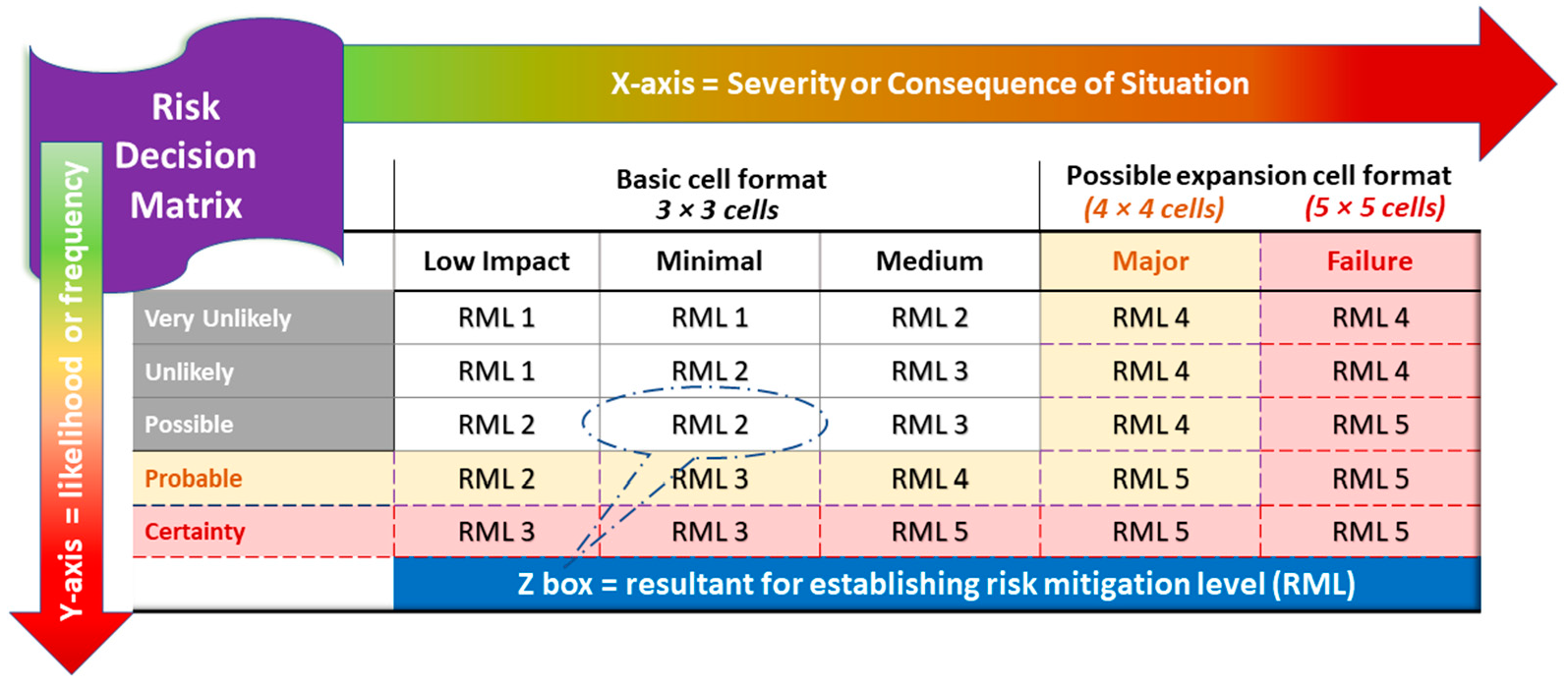
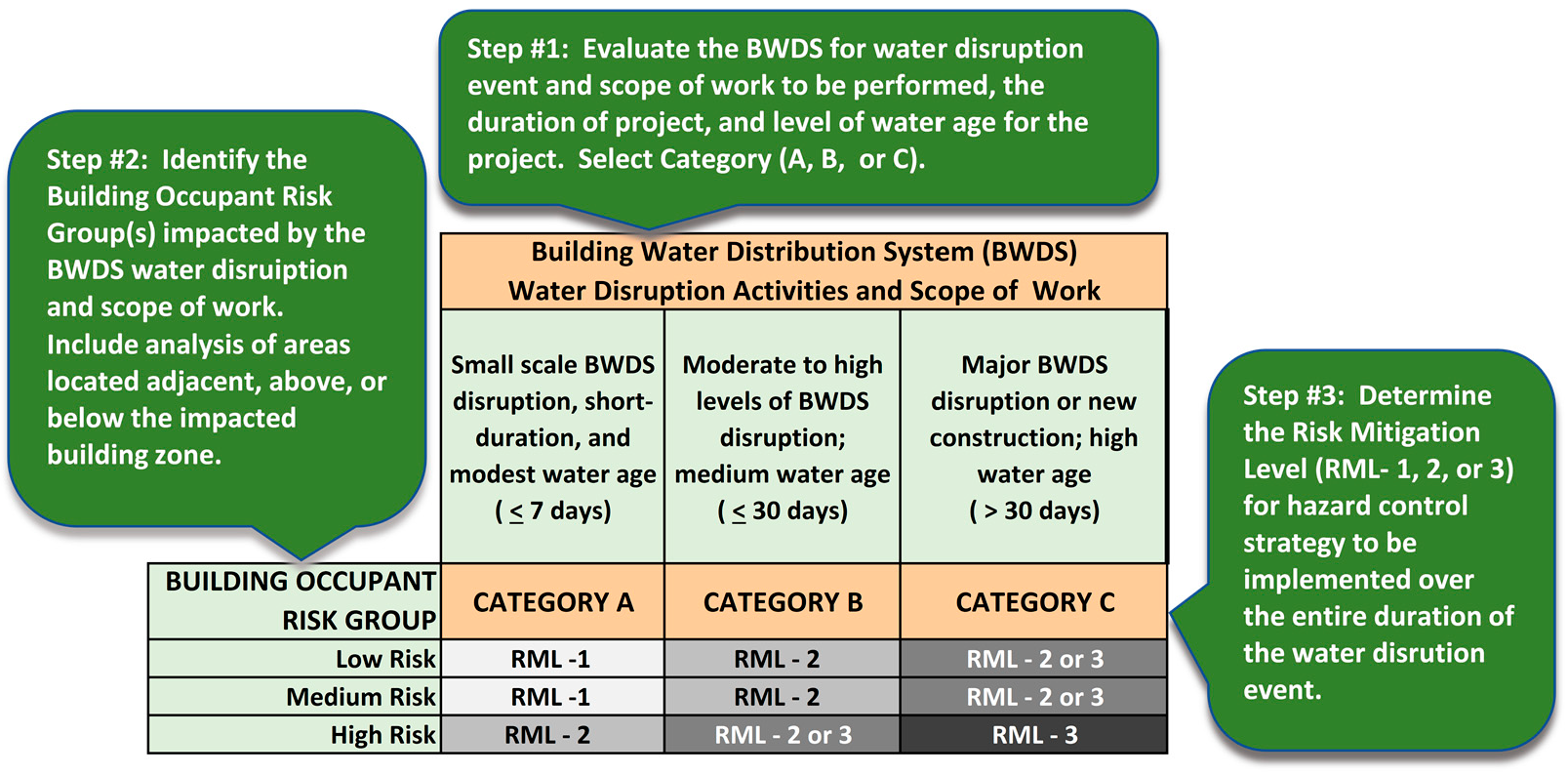


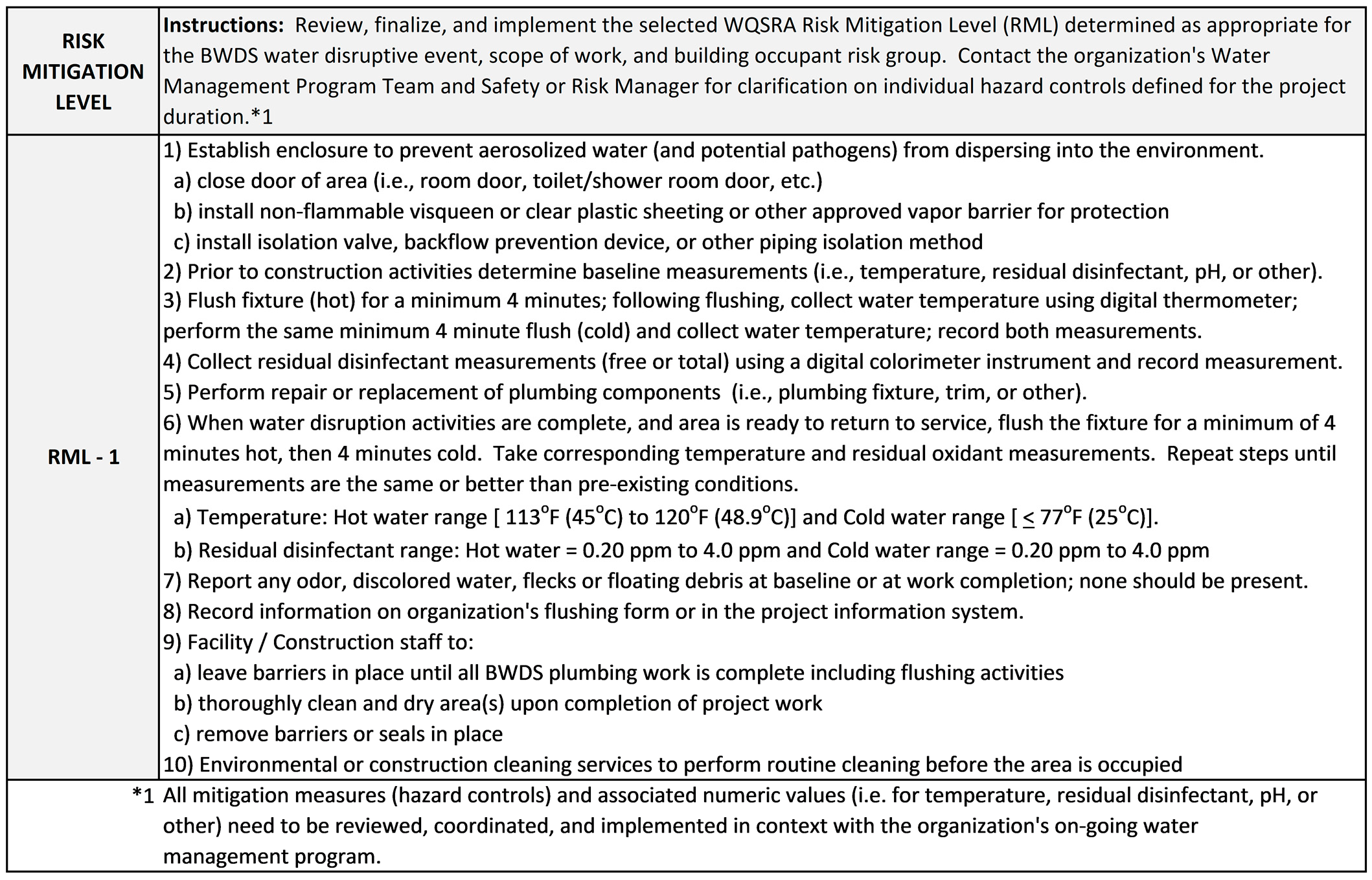
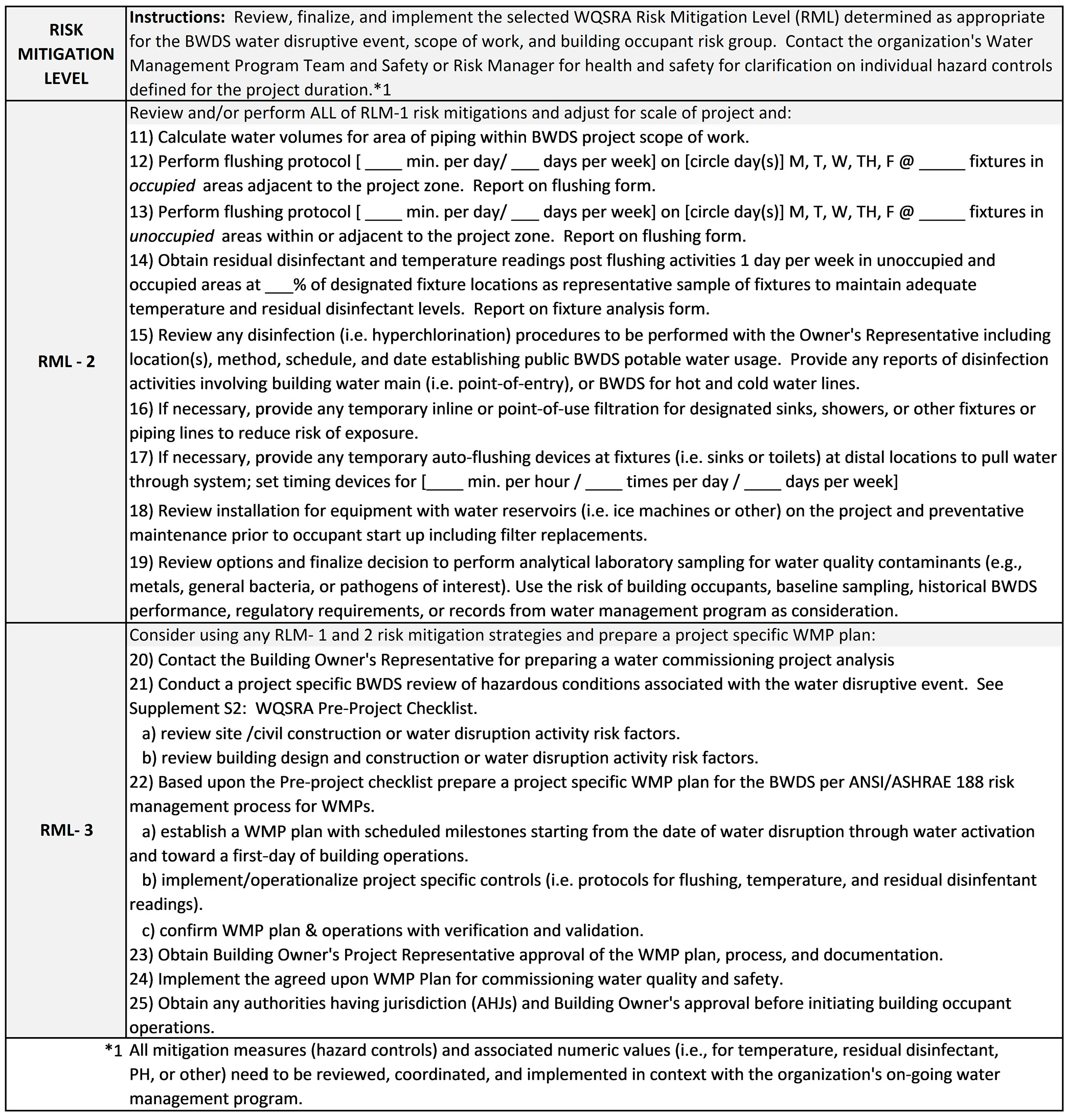
| WQRSA Mitigation Strategy | Description | Notes |
|---|---|---|
| Monitoring Residual Disinfectant (Free or Total) | Chlorine (measured as free residual oxidant, FRO) or monochloramine (measured as total residual oxidant, TRO) are the most common disinfectants [13,19]. | Reduced risk of growth and spread of pathogens in BWDSs with FRO between 0.20 and 4.0 ppm or TRO between 0.50 and 4.0 ppm [12]. |
| Monitoring and Maintaining Temperature | Maintain hot water ranges and cold water thresholds to discourage growth of Legionella [59]. | Cold water maintained at ≤77 °F (25 °C) and hot ≥113 °F while also avoiding scald risks [29]. |
| Flushing Protocols | Flushing BWDSs helps maintain temperature ranges, reduce water age, and introduce ”newer” water with adequate residual disinfectant into the system. Protocols are highly dependent on the volume of water within the BWDS; calculations may be needed to move and replace 100% of the total water volume in response to a disruption event. | Protocols should specify the minutes of flushing, number of days of the week for flushing, and the number of fixtures to be flushed. |
| Utilizing Filtration | Used to remove suspended particles from the potable water system before dispensing water at the terminal fixture [56]. Filters, screens, and other devices are commonly applied at the point-of-entry, inline, and/or at point-of-use. Any installation and removal of filtration devices requires careful consideration by the WMP team. | Filters with a pore size of 0.2 µm or less that comply with industry standardized test methods can provide a barrier to transmission of Legionella [56]. |
| Installing Physical Barriers | A physical construction or partition barrier may be necessary to contain and prevent aerosolized water droplets from dispersing into the air, preventing exposure to waterborne pathogens via inhalation [48]. | Isolate building occupants and/or ventilation intakes from any device or equipment used to spray water, test or repair fixtures, operationalize misters, or equipment that contains a water reservoir. |
| Recirculation and Hot Water Storage | BWDS components including hot water recirculation systems and hot water storage present Legionella exposure risks and must be flushed if impacted due to a water-disruptive event including construction. | The volume of water flushed for these components should be considered in the BWDS flushing protocols. |
| Equipment Installation, Cleaning, and Maintenance | Building equipment and devices (e.g., ice machines, misters, showers, pressure washers) should be scheduled for installation or return-to-service in a timely manner (i.e., close to building occupancy) to avoid high water age, bacteria growth and spread [10,56,60,61]. | Operators must properly clean and maintain all building equipment using water per the manufacturer’s recommendation prior to initial start-up and during routine operations. Similarly, remove and/or avoid premature installation of terminal fittings on fixtures (e.g., shower heads and hoses, aerators, faucet flow restrictors, screens, and filters in devices) before routine operations or in response to any water-disruptive event. |
| Disinfection | Disinfection is considered a highly effective method in the control of Legionella and can be a secondary, supplemental, or one-time (e.g., hyperchlorination) mitigation strategy [56]. | Important considerations when selecting disinfection method(s) include knowledge of the local municipal water or other water source, and the size and scope of the disruption event. |
| Verification and Validation Testing | Policies and procedures for analytical testing following water disruption events are the responsibility of the WMP team and must include the number of locations and the types of testing (e.g., physical, chemical, or microbial) to be performed [56,57]. | Each water disruption event is unique and requires an analysis of the size and scope of the event within the context of any existing or future WMPs to determine appropriate verification and validation test methods. |
Disclaimer/Publisher’s Note: The statements, opinions and data contained in all publications are solely those of the individual author(s) and contributor(s) and not of MDPI and/or the editor(s). MDPI and/or the editor(s) disclaim responsibility for any injury to people or property resulting from any ideas, methods, instructions or products referred to in the content. |
© 2023 by the authors. Licensee MDPI, Basel, Switzerland. This article is an open access article distributed under the terms and conditions of the Creative Commons Attribution (CC BY) license (https://creativecommons.org/licenses/by/4.0/).
Share and Cite
Griffin, S.C.; Scanlon, M.M.; Reynolds, K.A. Managing Building Water Disruptions in a Post-COVID World: Water Quality and Safety Risk Assessment Tool for Academic Institutions and School Settings. Buildings 2023, 13, 921. https://doi.org/10.3390/buildings13040921
Griffin SC, Scanlon MM, Reynolds KA. Managing Building Water Disruptions in a Post-COVID World: Water Quality and Safety Risk Assessment Tool for Academic Institutions and School Settings. Buildings. 2023; 13(4):921. https://doi.org/10.3390/buildings13040921
Chicago/Turabian StyleGriffin, Stephanie C., Molly M. Scanlon, and Kelly A. Reynolds. 2023. "Managing Building Water Disruptions in a Post-COVID World: Water Quality and Safety Risk Assessment Tool for Academic Institutions and School Settings" Buildings 13, no. 4: 921. https://doi.org/10.3390/buildings13040921
APA StyleGriffin, S. C., Scanlon, M. M., & Reynolds, K. A. (2023). Managing Building Water Disruptions in a Post-COVID World: Water Quality and Safety Risk Assessment Tool for Academic Institutions and School Settings. Buildings, 13(4), 921. https://doi.org/10.3390/buildings13040921






